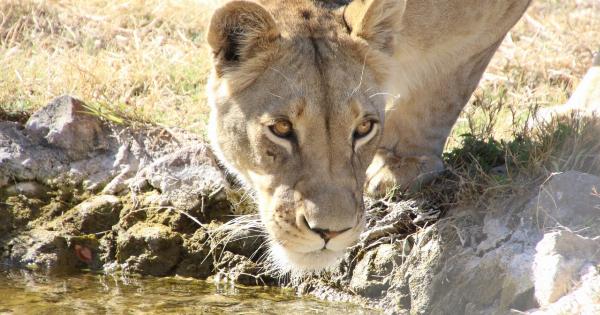Rabies is a deadly viral disease that affects the central nervous system of warm-blooded animals, including humans. It is primarily transmitted through saliva from the bite of an infected animal.
The virus causes inflammation of the brain and spinal cord, leading to various neurological symptoms. While rabies can occur in any mammal, it is particularly prevalent in wild animals such as raccoons, bats, skunks, and foxes.
Therefore, it is crucial to steer clear of unfamiliar animals displaying signs of rabies to protect yourself and prevent the spread of this dangerous disease.
The Dangers of Rabies
Rabies is not a disease to be taken lightly. Once symptoms appear, it is almost always fatal. The virus spreads rapidly through neural tissues, making early detection and treatment vital.
If left untreated, the disease progresses and leads to severe symptoms like anxiety, confusion, hallucinations, paralysis, and ultimately death.
Recognizing Rabies Symptoms in Animals
It is crucial to be aware of the common symptoms displayed by animals infected with rabies. These symptoms can vary depending on the stage of the disease but generally include:.
1. Aggression and Agitation
Animals with rabies often exhibit aggressive behavior, becoming easily agitated and prone to unprovoked attacks.
2. Disorientation and Restlessness
Rabid animals may appear disoriented, wandering aimlessly, and being unable to find their way.
3. Hypersensitivity to Touch, Light, and Sound
Animals infected with rabies may become hypersensitive to touch, light, and sound. They may react aggressively or attempt to flee when exposed to these stimuli.
4. Excessive Salivation
One common sign of rabies is excessive salivation or frothing at the mouth. This symptom occurs due to the inability to swallow caused by the virus affecting the animal’s throat muscles.
5. Erratic Movements
Rabid animals often display erratic movements, staggering or stumbling while walking. This lack of coordination is a result of the virus affecting the nervous system.
6. Unusual Vocalizations
Infected animals may emit strange sounds, such as growling, shrieking, or even inability to make any noise at all due to paralysis.
7. Paralysis
As the disease progresses, paralysis sets in and affects various parts of the body. This paralysis can start from the bitten area and slowly spread throughout the animal’s body.
8. Abnormal Behavior
Rabid animals often exhibit abnormal behavior. For example, nocturnal animals like raccoons may become active during the day, while bats may be found on the ground rather than in their usual roosting places.
9. Disheveled Appearance
Animals infected with rabies may have a disheveled and unkempt appearance, failing to groom themselves properly.
10. Paranoia and Fearfulness
Rabid animals may display signs of paranoia and fearfulness. They may retreat to a corner or act defensively when approached.
Why You Should Never Approach
Considering the potential dangers associated with interactions with unfamiliar animals showing signs of rabies, it is crucial to avoid approaching them. Here are some reasons why:.
1. Risk of Transmission
Rabies is primarily transmitted through the saliva of an infected animal. If you approached an animal displaying signs of rabies and it bit or scratched you, there is a significant risk of contracting the disease yourself.
This risk is not limited to wild animals; domesticated animals can also carry the virus if they have not been vaccinated or contracted the disease.
2. Aggressive Behavior
Animals infected with rabies can exhibit aggressive behavior, as the virus affects their brain and behavior control. Approaching such animals puts you at risk of a sudden, unprovoked attack, which can lead to severe injury or even death.
3. Inability to Predict Behavior
Rabid animals may behave erratically due to the impact of the virus on their nervous system. Their behavior becomes unpredictable, making it impossible to anticipate their reactions to human presence.
Approaching an animal showing signs of rabies introduces unnecessary risks and endangers your safety.
4. Difficulties in Diagnosis
Determining whether an animal has rabies just by looking at it can be challenging. Some rabid animals may not display obvious signs, especially early in the disease’s progression.
By the time symptoms become apparent, it could be too late for treatment.
5. The Importance of Disease Control
Avoiding contact with unfamiliar animals displaying signs of rabies is crucial for disease control. Rabies is a zoonotic disease, meaning it can be transmitted from animals to humans.
Preventing the spread of this disease requires minimizing interactions with potentially infected animals to reduce the chances of transmission.
What to Do Instead
If you come across an animal that you suspect may be rabid, it is essential to take the following steps:.
1. Maintain Distance
Do not approach the animal or attempt to touch or handle it in any way. Maintain a safe distance to minimize the risk of an encounter.
2. Contact Animal Control
Contact your local animal control or public health department to report the sighting and provide them with as much information as possible. They are equipped to handle situations involving potentially rabid animals and will take appropriate actions.
3. Protect Yourself and Others
If you notice an animal showing signs of rabies near your property, ensure that you and your family, including pets, are safely inside. Keep windows and doors closed until authorities can properly assess and handle the situation.
4. Vaccinate Your Pets
Make sure your pets are up to date with their rabies vaccinations. Vaccination provides a layer of protection and significantly reduces the risk of them contracting the disease.
Conclusion
When it comes to unfamiliar animals displaying signs of rabies, your best approach is to always err on the side of caution. Avoid any interactions with these animals and instead report the sightings to your local authorities.
Your safety and the prevention of rabies spread are of utmost importance.





























